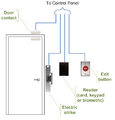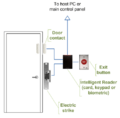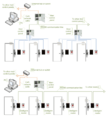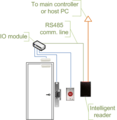Access control facts for kids
Access control is all about deciding who can use something and who can't. Think of it like a bouncer at a concert or a lock on your diary. It lets certain people use a specific thing, while keeping others out.
This "thing" could be a physical place, like a movie theater. Only people with tickets are allowed inside. Or it could be something digital, like a secret document on a computer. Only certain users should be able to read it.
To make sure only the right people get in, many places use special systems. These systems often rely on something unique about you.
Contents
What is Biometrics?
Have you ever seen someone unlock a phone with their face or finger? That's biometrics in action! Biometrics are systems that identify people using unique parts of their body.
Every person has unique features. These include their fingerprints, the pattern in their iris, their voice, or even their face. Because these features are special to each person, biometrics offer a fast and reliable way to check who someone is. This helps control who can access a place or an object.
How Fingerprint Scanners Work
One of the most common and reliable biometric systems uses fingerprints. You might have seen these at school, at an airport, or even on a smartphone.
Here's how it generally works:
- You place your thumb or another finger on a special scanner.
- The scanner reads your fingerprint pattern.
- It then compares this pattern to ones stored in a central database.
- If the patterns match, you are allowed access!
Most fingerprint systems don't store an actual picture of your fingerprint. Instead, they create a "template." A template is like a special code or number. This code is calculated from different unique points on your fingerprint.
Using a template makes the system more secure. It prevents people from trying to sneak fake fingerprint images into the database. When you scan your finger, the system quickly creates a new template from it. It then compares this new template number with the one saved in the database.
These systems are pretty smart! They can often still work even if your fingers are a bit dry, greasy, or have small cuts.
Other Biometric Systems
Besides fingerprints, there are other cool biometric systems. Some use the pattern in your retina or iris. Others might scan the shape of your palm or even your face. There are also systems that recognize your voice pattern. Each of these methods uses a unique part of you to grant or deny access.
Images for kids
-
An underground entrance to the New York City Subway system.
See also
 In Spanish: Control de acceso para niños
In Spanish: Control de acceso para niños
















